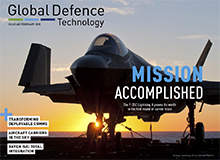
When carrier trials of the F-35C began last November, prime contractor Lockheed Martin and the US military had a lot to prove. But during more than ten days of intense at-sea testing, the next-generation aircraft demonstrated it had shucked off former niggles and performed with exceptional style. We review footage from the trials to find out how the F-35C will operate when deployed on the new Ford-class carriers in 2018.
We also take a look at Airbus’ new deployable comms system for the NATO Response Force which enables personnel to communicate in any environment, catch up with DARPA’s efforts to develop flying launch platforms for swarms of UAS based on existing military transport aircraft, and find out how Raytheon’s Raven ISR software brings big data processing power to laptops.
Moreover, we speak to PETA about its campaign to end the use of live animals in military training – a cruel practice which is being rendered unnecessary by the emergence of ever more advanced medical simulators – and find out how a combination of new technology and traditional pastimes is keeping naval crews occupied between duties during long missions at sea.
In this issue
Transforming Deployable Comms
For the NATO Response Force, the ability to set up secure communications in any environment is a matter of life and death. Berenice Baker finds out how Airbus’ new deployable communication and information system enables personnel to communicate where even basic infrastructure has been destroyed.
Click here for the full article.
How well do you really know your competitors?
Access the most comprehensive Company Profiles on the market, powered by GlobalData. Save hours of research. Gain competitive edge.

Thank you!
Your download email will arrive shortly
Not ready to buy yet? Download a free sample
We are confident about the unique quality of our Company Profiles. However, we want you to make the most beneficial decision for your business, so we offer a free sample that you can download by submitting the below form
By GlobalDataA Humane Alternative
Every year, live pigs and goats are shot at, repeatedly stabbed, have their limbs amputated with tree trimmers and are even blown up so that NATO military medical trainees can learn to treat traumatic injuries. As new simulation technology offers increasingly realistic humane alternatives, Berenice Baker asks whether this barbaric practice could finally be coming to an end.
Click here for the full article.
The Integration Game
Raytheon UK has launched a highly interoperable ISR software platform that can pack multilayered intelligence capability into a laptop. Berenice Baker looks into the platform and a new airborne mission management package that uses its output.
Click here for the full article.
Aircraft Carriers in the Sky
Unmanned aerial systems have already transformed military operations but an ambitious new project from DARPA could take the capability even further by deploying a cooperative swarm launched from a mothership. Claire Apthorp reports on the significant progress already made in the quest for aircraft carriers in the sky.
Click here for the full article.
Trial & Success
When carrier trials of F-35C Lightning II began last November, Lockheed Martin and the US military had a lot to prove. During more than ten days of intense at-sea testing, two carrier variant fighter jets repeatedly took off from, and landed on, the flight deck of USS Nimitz. We review the footage to find out just how the F-35 will operate when deployed on the new Ford-class supercarriers in 2018.
Click here for the full article.
A Life at Sea
Ship-board entertainment has come a long way since the Nelson era of grog, sea shanties and jigging a hornpipe on deck. With crew members at sea for months at a time and space at a premium, Berenice Baker finds out how technology has stepped in to keep crew occupied between duties and why some activities remain distinctly old-fashioned.
Click here for the full article.
Next issue preview
Russia’s aggression in the Ukraine has triggered a bout of investment by NATO states in neighbouring regions, but Russia itself has spent so extensively in the past twelve months it has single-handedly slowed the decline of global arms sale. We investigate what the Kremlin’s extensive equipment shopping list means for the Russian defence industry and the country’s frail relations with the West.
We also take a look inside the world’s largest climatic testing facility, which can simulate just about any weather conditions on the planet to test the performance of military aircraft before they are deployed, explore the capabilities of the US Army’s JLENS aerial surveillance aerostat, review the top anti-submarine warfare helicopters and find out how the US Navy has extended its hazard avoidance planning tools from submarines to surface vessels.
Digital magazine FAQ
Global Defence Technology is available on the iPad and as a free desktop version*. You can download our app or read the latest issue here.
View the archive of back issues.
Sign up for your subscription here.
*Browser compatibility: The desktop version can be viewed in the latest two version of Chrome, Firefox and Safari, as well as in Internet Explorer 9 and 10. Some features may not be compatible with older browser versions.




